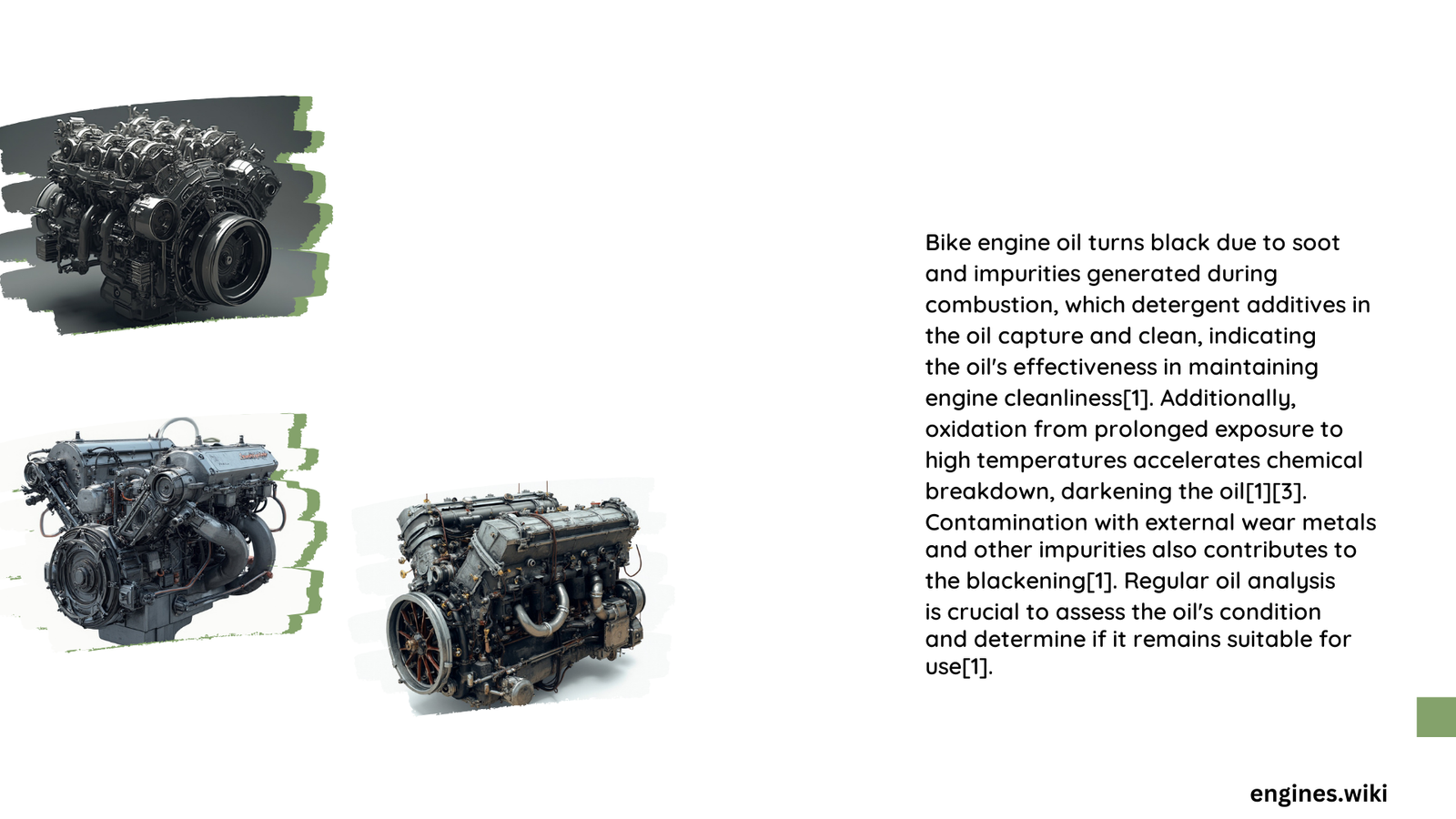Bike engine oil turning black is a common phenomenon that often concerns motorcycle owners. This color change is primarily due to the oil’s function of cleaning and protecting the engine. As it circulates, the oil collects contaminants, undergoes thermal breakdown, and experiences oxidation. These processes, combined with engine wear and combustion byproducts, contribute to the darkening of the oil. Understanding why this happens can help riders maintain their bikes more effectively and make informed decisions about oil changes.
What Are the Main Causes of Engine Oil Turning Black?
The primary reasons for engine oil turning black include:
- Contaminant accumulation
- Thermal breakdown
- Oxidation
- Engine wear
- Combustion byproducts
Let’s delve deeper into each of these factors:
How Do Contaminants Affect Oil Color?
Contaminants play a significant role in darkening engine oil:
- Carbon Deposits: These black deposits form on engine parts and are picked up by the oil during circulation.
- Soot: A byproduct of incomplete combustion, soot particles are extremely small (less than one micron) and can evade even fine filtration systems.
Both carbon deposits and soot contribute significantly to the oil’s dark color.
What Role Does Thermal Breakdown Play?
Thermal breakdown is a crucial factor in oil discoloration:
- Heat Cycles: Repeated exposure to high temperatures (typically 195°F–220°F or 90°C–104°C) during engine operation causes the oil to darken.
- Additive Breakdown: The thermal breakdown of some additives in the oil accelerates the darkening process.
How Does Oxidation Contribute to Oil Darkening?
Oxidation is another key factor in oil discoloration:
- Chemical Reaction: When oil molecules interact with oxygen, it leads to chemical breakdown, similar to how an apple browns or iron rusts.
- Heat Acceleration: High temperatures accelerate this oxidation process, contributing further to the oil’s darkening.
What Specific Factors Cause Black Engine Oil in Motorcycles?

Several factors specific to motorcycles contribute to oil darkening:
How Does Engine Wear Affect Oil Color?
Engine wear contributes to oil discoloration through:
- Wear Particles: These small metal particles, although often caught by the oil filter, can still be present in the oil, especially if they are very small.
- Metal Shavings: Similar to wear particles, these can darken the oil but are typically caught by the filter.
What Role Do Combustion Byproducts Play?
Combustion byproducts are significant contributors to oil darkening:
- Soot: As mentioned earlier, soot is a primary contributor to the oil turning black.
- Carbon Deposits: These deposits, formed during combustion, can quickly change the oil’s color as it circulates through the engine.
How Do Moisture and Dirt Impact Oil Color?
While not primary causes, moisture and dirt can contribute to oil degradation:
- Moisture: Can lead to oil degradation and potentially sludge formation, which can darken the oil.
- Dirt: Microparticles that escape air filters can be carried by the oil, contributing to its discoloration.
What Are the Effects of Engine Wear on Oil Quality?
Engine wear has several effects on oil quality:
How Do Wear Particles and Metal Shavings Affect Oil?
- Viscosity Increase: These particles can increase the oil’s viscosity.
- Color Change: They contribute to the darkening of the oil.
- Filtration: Most wear particles are caught by the oil filter, especially those larger than 20 microns.
What Impact Do Carbon Deposits Have?
Carbon deposits are a significant factor in oil darkening:
- Rapid Color Change: These deposits are usually black and can quickly change the oil’s color as it circulates.
- Continuous Process: As long as carbon deposits are present in the engine, they will continue to darken the oil.
What Are the Quantifiable Metrics of Oil Degradation?
Here are some measurable aspects of oil degradation:
| Metric | Description | Impact |
|---|---|---|
| Particle Size | Particles > 20 microns caught by standard filters | Affects filtration efficiency |
| Oil Viscosity | Can be affected by wear particles and contaminants | Indicates oil condition |
| Soot Content | Particles < 1 micron, often evade filtration | Major contributor to oil darkening |
How Quickly Does Oil Degradation Occur in Motorcycles?
The timeline for oil degradation can vary:
How Fast Can Oil Turn Black?
- Oil can turn black relatively quickly, sometimes after just one ride.
- Existing contaminants in the engine can accelerate this process.
- Heat cycles can darken the oil within a few hours of operation.
What Are the Cost Implications of Frequent Oil Changes?
Frequent oil changes due to discoloration can be expensive:
- Unnecessary Changes: Changing oil solely based on color can lead to unnecessary expenses.
- Manufacturer Recommendations: It’s crucial to follow the oil change intervals recommended by the vehicle manufacturer.
What Are the Recommended Oil Types and Additives?
To combat rapid oil degradation:
- Synthetic Oils: Oils like AMSOIL synthetic diesel oils or ELF Moto 4 Tech have high dispersant additives.
- Antioxidants: These additives help slow down the aging process of the oil.
Conclusion
Understanding why bike engine oil turns black is crucial for proper motorcycle maintenance. While color change is normal and often rapid, it’s not always an indicator of oil quality. Factors like contaminants, thermal breakdown, oxidation, and engine wear all contribute to this phenomenon. However, it’s essential to rely on manufacturer-recommended change intervals rather than color alone. Using high-quality synthetic oils and following proper maintenance schedules can help ensure optimal engine performance and longevity.
